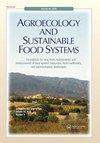Functional properties of the dietary fibers and their using in the manufacturing technology of fish products
IF 2.6
3区 农林科学
Q1 AGRICULTURE, MULTIDISCIPLINARY
Agroecology and Sustainable Food Systems
Pub Date : 2023-07-13
DOI:10.21323/2618-9771-2023-6-2-233-244
引用次数: 0
Abstract
This review presents the up-to-date scientific ideas about the role of dietary fibers of plant origin (fiber and hydrocolloids) and animal origin (chitosan and collagen) in the food systems. The main attention is focused on their significance and methods of their using in the manufacturing technology of fish products. Dietary fibers are considered as important components of a diet; the dietary fibers prevent certain disorders and regulate the physical and mental health of the population. Consuming of fish products contributes both to the enrichment of raw materials with functional ingredients, as well as to the increasing in the efficiency of processing of raw materials, including underestimated and underutilized aquatic biological resources. The review shows the influence of dietary fibers on the restructuring of fish muscles systems, their ability to hold water and fats, to stabilize emulsions, to change their sensory characteristics, to increase the yield of the finished food products, and also their ability to influence the shelf life of the finished food product. The mechanisms of involving the certain groups of dietary fibers into the physicochemical and biochemical processes of interaction with the components of fish raw materials are considered; the influence of various conditions of processing on gelation and emulsification is studied. The factors that provide antimicrobial and antioxidant effects of various dietary fibers are given. The properties and examples of using the commercial fiber preparations obtained from various sources are analyzed separately, and the significance of the molecular structure of chitosan and collagen for ensuring the specified technological parameters is considered. It is concluded that using the dietary fiber in the manufacturing process of fish products increases the economic efficiency of production and contributes to the development of the healthy food industry.膳食纤维的功能特性及其在鱼制品生产工艺中的应用
本文综述了植物源膳食纤维(纤维和水胶体)和动物源膳食纤维(壳聚糖和胶原蛋白)在食品系统中作用的最新科学观点。重点介绍了它们在鱼类产品生产技术中的意义和应用方法。膳食纤维被认为是饮食的重要组成部分;膳食纤维可以预防某些疾病,调节人群的身心健康。食用鱼产品既有助于原料中功能性成分的丰富,也有助于提高原料加工的效率,包括低估和未充分利用的水生生物资源。这篇综述显示了膳食纤维对鱼类肌肉系统重组的影响,它们保持水和脂肪的能力,稳定乳剂,改变它们的感官特性,增加成品食品的产量,以及它们影响成品食品保质期的能力。探讨了某些膳食纤维与鱼类原料组分相互作用的理化生化过程的机制;研究了不同工艺条件对凝胶和乳化的影响。给出了各种膳食纤维抗菌和抗氧化作用的影响因素。分别分析了各种来源的商品纤维制剂的性能和使用实例,并考虑了壳聚糖和胶原蛋白的分子结构对保证规定工艺参数的意义。综上所述,在鱼制品生产过程中使用膳食纤维可提高生产的经济效益,有利于健康食品产业的发展。
本文章由计算机程序翻译,如有差异,请以英文原文为准。
求助全文
约1分钟内获得全文
求助全文
来源期刊

Agroecology and Sustainable Food Systems
AGRICULTURE, MULTIDISCIPLINARY-GREEN & SUSTAINABLE SCIENCE & TECHNOLOGY
CiteScore
4.80
自引率
7.70%
发文量
73
期刊介绍:
Agroecology and Sustainable Food Systems is devoted to the rapidly emerging fields of agroecology and food system sustainability. By linking scientific inquiry and productive practice with transformative social action, agroecology provides a foundation for developing the alternative food systems of the future. The journal focuses on the changes that need to occur in the design and management of our food systems in order to balance natural resource use and environmental protection with the needs of production, economic viability, food security, and the social well-being of all people.
Agroecology and Sustainable Food Systems examines our current food systems from production to consumption, and the urgent need to transition to long-term sustainability. The journal promotes the study and application of agroecology for developing alternatives to the complex problems of resource depletion, environmental degradation, a narrowing of agrobiodiversity, continued world hunger, consolidation and industrialization of the food system, climate change, and the loss of farm land. The journal uses a food systems approach, and seeks experiences in agroecology that are on-farm, participatory, change-oriented, and backed by broad-based methodologies of sustainability analysis and evaluation.
 求助内容:
求助内容: 应助结果提醒方式:
应助结果提醒方式:


